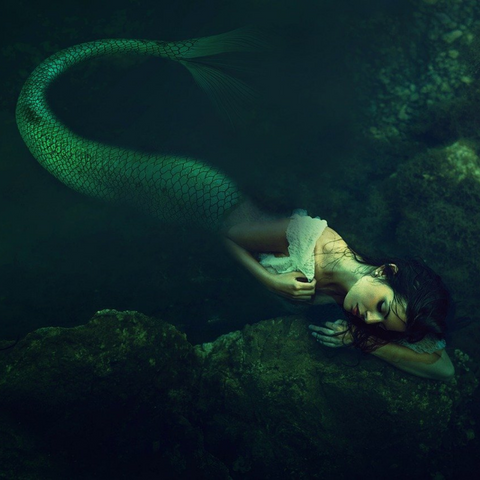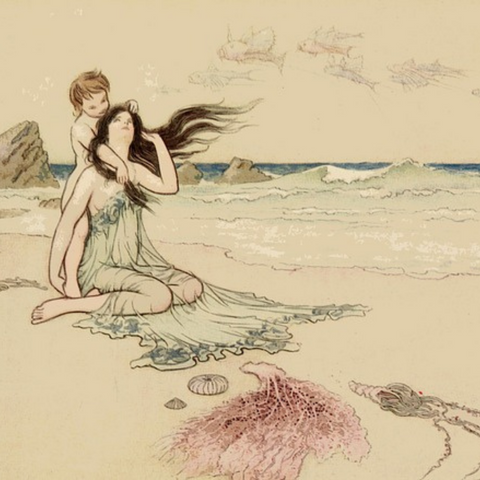Global Stories about Mermaids... Syria, China, Scotland Greece, Russia
Where do mermaids live around the world?
Before I answer that question, I thought it would be best to first introduce you to the first mermaid and how she came to be.
1. A Syrian Beginning.
In Ancient Syria, we see many such Gods linked to the Sun, Moon, Sea, Death, Thunderstorms, and more. One such Goddess was Atargatis: Goddess of love and fertility and her consort was Hadad, God of thunderstorms. According to one version of the myth, she fell in love with a shepherd (Often said to be Hadad himself, though not a God here) and conceived a child. Since he was a mortal, he was unable to withstand her power and love and died. Heartbroken, Atargatis could not live without him and as soon as the child was born, she plunged into a lake. It was better to die and join the father of her child than live a life without him. Known for her radiant beauty, the Gods could not allow her to die and they transformed her into a half fish. Another variation of the story is that a fish rescued the Goddess from a watery death. In any case, this is a short version of the legend of the first mermaid.

Influence on other cultures
Mermaids are always pictured as having flowing hair entangled with shells, and beauty beyond the realms of the earth. But the origin of these creatures is a sad one that paradoxes their characteristics. With Hadad as a God, it seems to be a perfect match: Love weds thunderstorms = Tale of the Mermaid Goddess. So we see that the people of Ancient Syria managed to explain the sea and all it encompasses through the marriage of Hadad and Atargatis. These archaic ideas also influenced Greek religion. They too had a Goddess with similar attributes: Aphrodite. The story here is that she emerged from the foamy waters where her father Uranus lay chopped up. But more on that later…(perhaps in another post!)
2. Tales from China (Chinese Mermaid)
We know China as a country rich in tradition and dense with population. Well, the two key aspects of this mystical country merge into the existence of mythical beings. As the most populated country on Earth, we’d expect mermaids too right? Today I will be discussing a prominent classic: The ‘Shan Hai Jing.’
Translated, it reads ‘ The Classic of Mountains and Seas’ and records several supernatural creatures that “existed” in China like the Ba She, Chenghuang, etc. I will only focus on the “Seas” part cause… well isn’t it obvious?
Mermaids in The Shan Hai Jing
The book mixes reality and fantasy to create a text like no other. Though it mentions various beasts both real and mythological, it also describes their importance and value. That’s why its a treasure. Mermaids or “Diren” are just some of the weirdly wonderful creatures to make an appearance in the book. However, the appearances of these oriental mermaids are a bit different than our concept of “The Little Mermaid.”

Mermaid interaction with people
For a start, there seems to be a variety of mermaids in the book; different names, features, characteristics, even lifestyles! Throughout the book, they are referred to as ‘Fish Women,’ ‘ Shark people,’ etc. One species of mermaid called “Lingyu,” is described as having a human face, fishtail, and…feet! Try to picture that for a second. This mermaid can not only swim but also walk on land and interact with humans. The other type called “Diren,” is more attuned to our idea of a mermaid: Human torso and fishtail. Though they weren’t the prettiest of creatures. Other species make silk fabrics that don’t get wet ( master weavers), conduct business with humans, and can even resurrect from the dead! A mermaid breed was also popular for their tears which transformed into gorgeous pearls and were presented as gifts or bartered in exchange for supplies. Lamps burned forever because of the gift of mermaid fat that kept them burning. Mermaids in China were quite diverse and swam amongst common sea life like Mackarel. Each species possessed unbelievable attributes and unique traits much like the culture and people of China.

3. The Mysterious waters of Scotland (Mermaid found in Scotland)
Fiery Scotland is more than bagpipes, kilts, and castles. It is also the birthplace of strange mystical creatures like Kelpies, Selkies, Loch Ness Monster, Bean-Nigh, and more. One can then expect a mermaid version too…

The Ceasg.
Gaelic is the ancient, Celtic language of Scotland that is still spoken today. The term ‘Ceasg’ in Gaelic is ‘Maighdean na tuinne’ meaning ‘Maid of the wave.’ This mermaid is described as a ravishing woman with the tail of a salmon. ( Yes, much more specific compared to other mermaid stories.) Ceasg’s live in streams, lakes, rivers and if captured, she may grant 3 wishes to the captor. Often they marry humans out of desire or force but eventually return to their watery abodes. They are spiteful ( though who wouldn’t be with a forced marriage, all the while taken out of their homes? ) The only way to subdue one such creature is to capture its soul and hide it away. Selkies are also a part of Scottish Folklore though they are beguiling women who live in the seas in the form of seals and can transform into humans on land. Since I am more biased towards “fishy” derrières, I’ll leave out selkies for now…

4. The Great Myths of Greece (Mermaid greek mythology)
Greeks are famous for myths and legends. From the Dashing Hercules and the Great Zeus to Uncontrollable Hades and poor Narcissus. Unfortunately, Mermaids didn’t make the cut into “The Awesome and Stunning” clique. Let me just say, this may be the most shocking and quirky image of a mermaid you have seen and probably ever will see. Now that I have warned you, let’s take a look…
First off: Siren, not Mermaid
A siren is the greek version of a mermaid and is perhaps the most dangerous of them all. Half an alluring woman and half…bird! Sirens beckon passing sailors with their enchanting music and song. Eventually, the unfortunate sailors meet a watery grave.

The birth of Sirens
As the story goes, sirens were the offspring of the river God Achelous and one of the 9 muses. Achelous was attributed to the longest river in Greece of the same name. Sirens are a part of the story of Odysseus, where they attempt to lure him to his doom. However, he stuffs the ears of his fellow sailors with wax and then orders the men to tie him to the mast so that he may hear their beautiful melodies while still being out of their reach. He thus manages to sail by without harm. Upon their failure, the sirens plunged themselves into the sea and died. Demeter gave them the wings of a bird to be able to fly and cover a greater distance. Eventually, unable to find her, they retired to an island and lived only to charm and kill sailors. They also appear in the story of the Argonauts where once again, another sailor evades their charms: Orpheus: a great musician who drowns out the singing with his powerful tune. The island of the Sirens is a desolate land, smothered with the bones of unlucky seamen and the rotting flesh of those still uneaten. Those poor unfortunate souls!

5. Rich and colorful Russia (Russian Mermaid)
Mermaids in Russia are part of Slavic folklore ( Russia, Macedonia, Czech, etc.) The name here is ‘Rusalki.’ They are the souls of drowned women who have killed themselves because of an unfortunate love life. The Rusalki can also be men (Rusalka) and as the legend goes, anyone who dies in a lake or river during Green week transforms into such a creature. The first ‘Rusalki.’ Green week, celebrated in Russia, was a week of agricultural bounty and a week where the ‘Rusalki’ were at their most active state. They were described as gorgeous women with flowing green or blue hair, frighteningly malicious and vicious to people. They were the nymphs of fertility and water.

Thus, during Green week, the locals would invoke them so that they may bring about a rich, bountiful harvest for the coming year. Rusalki in different areas of Russia, have varying appearances and traits, both positive and negative. In some stories, they are lovely, enchanting women and in others, they are abhorrent, ugly women. During this pivotal time, also called Rusalki week, the locals avoided the waters at all costs for fear that the ‘’Rusalki’’ would drown them. They would emerge from their watery abode and sit on the branches of birch trees, singing sweetly and combing their hair with bones and drowning anyone who comes close. At the end of the week, the people would conduct a ritual to ward off the mermaids thereby keeping the natives safe. After this week, the grass is greener and the crop sweeter.


